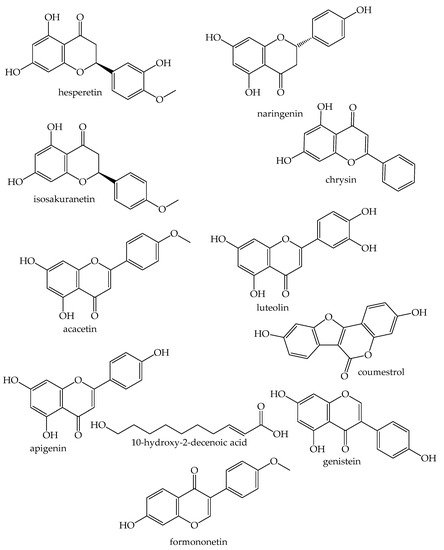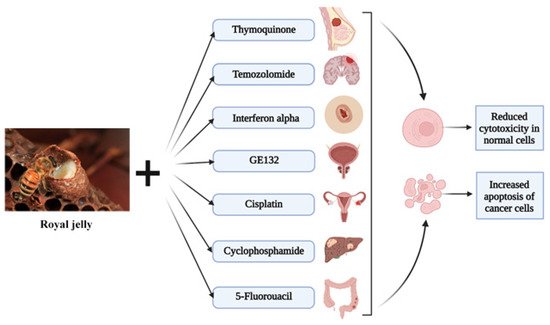Royal jelly (RJ) is produced by the hypopharyngeal and mandibular salivary glands of young nurse honeybees. RJ contains bioactive substances, such as carbohydrates, protein, lipids, peptides, mineral salts and polyphenols which contribute to the appreciated biological and pharmacological activities. Antioxidant, anticancer, anti-inflammatory, antidiabetic, and antibacterial impacts are among the well-recognized benefits. The combination of RJ or its constituents with anticancer drugs has synergistic effects on cancer disorders, enhancing the drug’s effectiveness or reducing its side effects.
- royal jelly
- cancer
- anticancer drugs
1. Introduction
2. Anticancer Effects of Royal Jelly
It is well-known that some bee products have a positive impact on stopping cancer formation [8][31]. The antiproliferative activity of RJ was investigated, and RJ revealed potential anticancer properties owing to the inhibition of tumorigenesis, cancer cell proliferation and/or metastasis, via the inhibition of tumor-induced angiogenesis and/or the activation of immune function [9][32].
RJ exhibited a significant reduction in tumor mass and the serum concentrations of interleukin (IL)-4 and IL10, and cytokines released from type 2 T helper (Th2) cells, whereas the concentrations of IL-2 cytokines produced from type 1 T helper (Th1) cells, interferon (IFN)-α, superoxide dismutase (SOD), as well as total antioxidant machinery showed a significant elevation in an induced breast tumor. IFN-α level elevation manifested the role which RJ plays in immunomodulation. The enhanced release of antioxidant markers in the liver and kidney was another strong indicator of the antioxidant and immunomodulatory activities of RJ, with their possible association in the suppression of tumor growth in animal models [10][33].
However, it is also reported that RJ protein impedes the growth of human breast cancer cell lines induced by bisphenol A (BPA)—through the inhibition of the signaling pathway for cell proliferation induced by E2, and not as believed due to the inhibition of E2 attached to ER5. BPA is an estrogen-like substance used in commercial products such as polycarbonate plastics and synthetic resins, which are applied to coat the inside of beverage cans, and used to manufacture food wrapping paper and dental sealants. BPA has estrogenic activity and binds to estrogen receptors, stimulating the proliferation of human breast cancer MCF-7 cells [11][34] through the activation of the protein kinase/phosphoinositide3 kinase signaling pathway which is induced by estrogen receptor/human epidermal growth factor receptor 2 (HER2)/mitogen [12][35]. The crude RJ stops the damage of bisphenol A, which is a predisposition factor and hazardous insult that induces human breast cancer cell growth [11][34].
RJ supplementation decreased the concentrations of TNF-α and transforming growth factor (TGF) -β, thus dramatically reducing the paraneoplastic syndrome in RCC patients. The observed suppression of the malignant invasiveness and the decrease in the tumor weight may be attributed to the presence of 10-hydroxy-2-decenoic acid (10-HDA), which is a remarkable fatty acid among the lipid content of RJ [13][37]. In comparison to other bee products, this fatty acid is exclusively found in RJ at relatively high concentrations, as illustrated in Figure 1 [14][15][38,39].
4. Interaction with Anticancer Drugs
Thymoquinone is a bioactive component of the Nigella sativa plant and has been proved effective in treating cancer, explained by its immunoenhancing and anti-oxidative properties [23][60]. Moubarak et al. demonstrated that the administration of RJ at a dose of 5 µg/mL combined with thymoquinone at the concentration 10 µmol/L for 24 h could reveal the remarkable induction of the caspase-3 apoptotic pathway and the death of human breast cancer cells MDA-MB-231. These findings were reproduced in different cell lines with similar effects and without any cytotoxic changes to normal human small intestinal cells [24][14].
Temozolomide is a conventional chemotherapy used against brain cancer, and approved by the Food and Drug Administration (FDA) in 2005 [25][61]. The addition of RJ extract (30 µg/mL) to temozolomide (20 µM) has synergistically elevated the cytotoxicity of the drug on the human glioma cell line U87MG [7].
Interferon alpha is a multi-subtype protein which is used as an antitumor drug. RJ and its active compound 10-HDAA were found to improve the potency of HulFN-αN3 when applied to the human colorectal adenocarcinoma cell line CaCo-2. The same report claimed the mechanism of action to be due to the augmentation of lipid peroxidation, the inhibition of cell proliferation and the depletion of glutathione (GSH) levels in colon cancer cells [26][16].
GE132 plus is a nutraceutical supplement which contains five strong antioxidant compounds, Ganoderma lucidum extract, RJ, resveratrol, sulphraphane and lycopene in one capsule (500 mg) [27][17]. In Traditional Chinese Medicine, it has been utilized for decades as a health-promoting factor for treating various diseases owing to its therapeutic properties, including the anticancer, immunopotentiator, and anti-hypertensive impacts [28][62]. Significant anti-proliferative effects through the potential inhibition of angiogenesis have been recognized upon administration of GE132 plus to breast cancer cell lines (MCF-7), prostate cancer cell line (PC3), and the human colorectal adenocarcinoma cell line (SW48). On the other hand, GE132 plus did not show significant cytotoxicity on mesenchymal stem cells or peripheral blood collected from healthy donors in vitro. The same report revealed that higher concentrations of GE132 plus (500–2000 µg/mL) exhibited a cytotoxic effect to normal human vascular endothelial cell line EA.hy 926.
Although modern chemotherapeutic drugs have shown an efficient improvement in patient survival, the adverse effects of these drugs represent a great concern for cancer patients as well as physicians. Cisplatin is a well-known drug that is used in many diseases [29][63] and an active drug in anticancer chemotherapy as well, yet its adverse hepatotoxic and nephrotoxic effects are the biggest challenges facing cancer patients [30][64]. Some in vivo and clinical studies have shown that the synergistic interaction of RJ with cisplatin, when both are applied simultaneously, has considerably attenuated the previously observed nephrotoxic and hepatotoxic effects.

